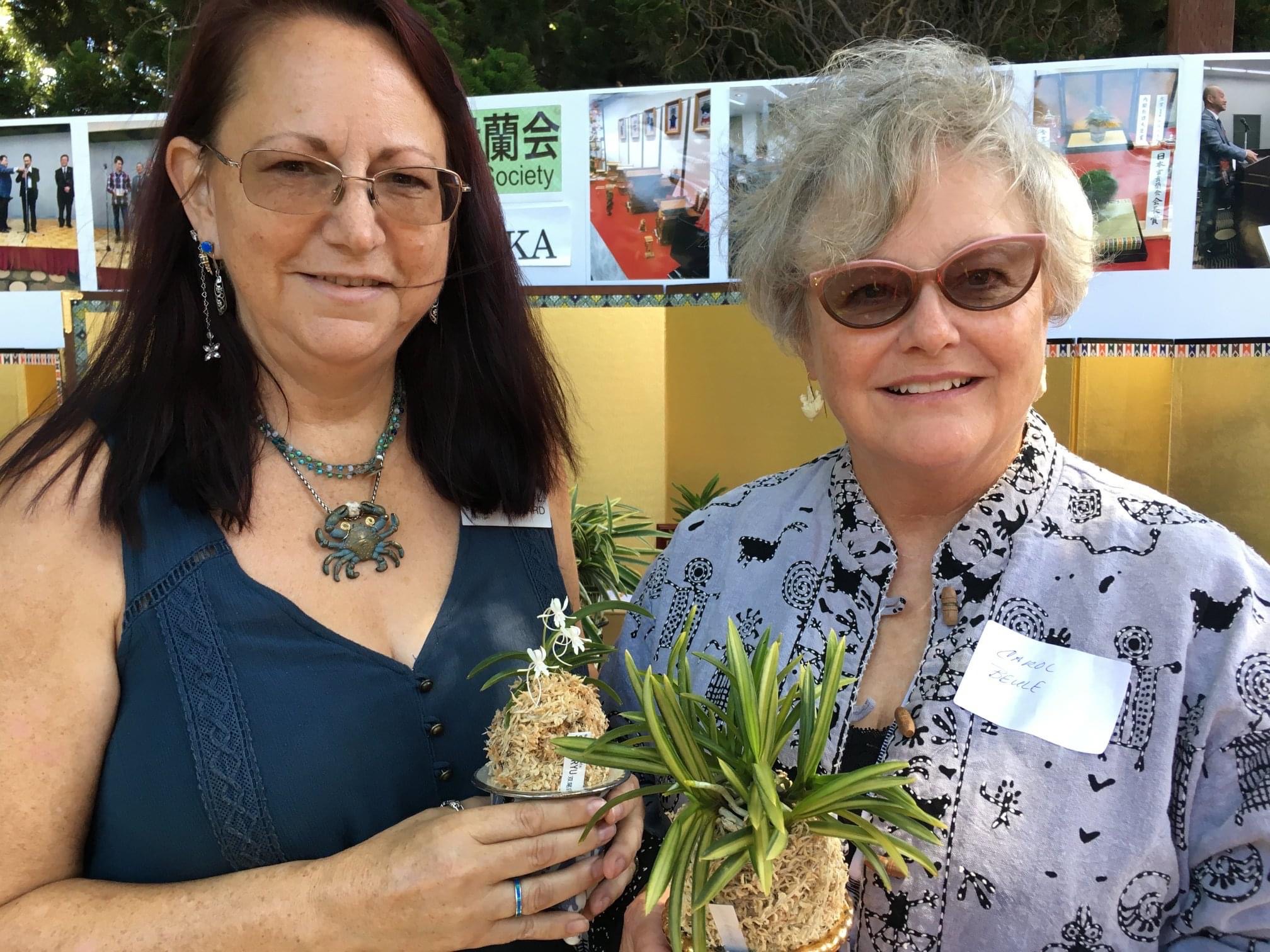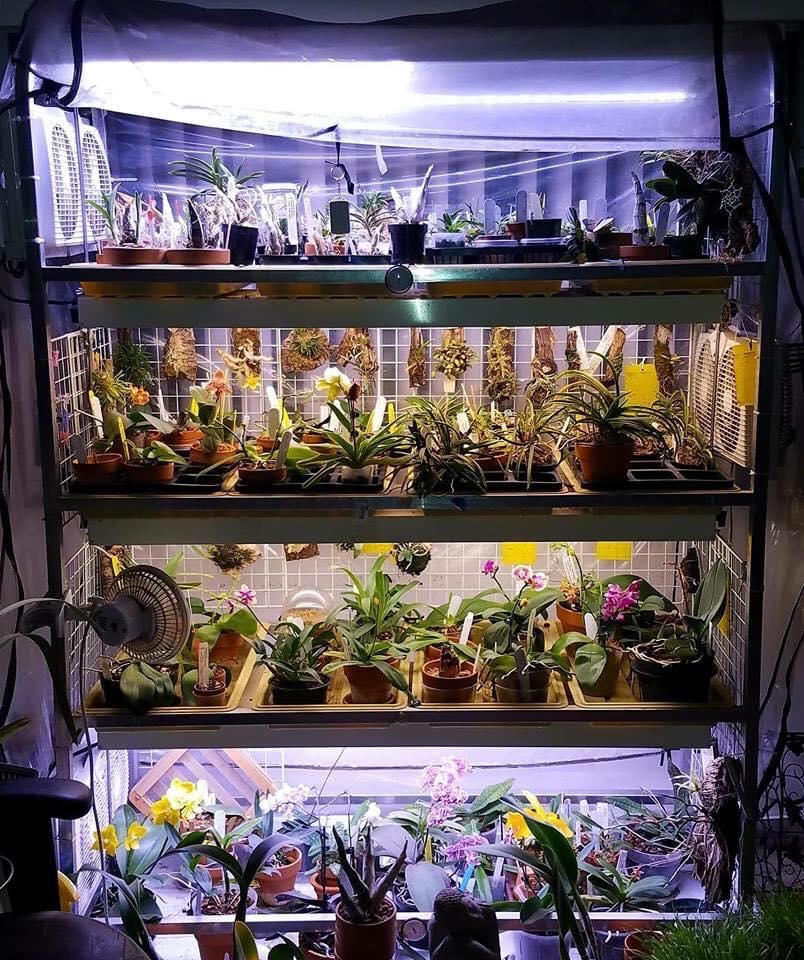
Donna poses with her Rhynchattleanthe Maxima's Effect 'Pale Moon', which received an AM/AOS at Pacific South outreach judging at the OSSC meeting in Burbank, May 14, 2018.


Before the pandemic, we had already realized that many people in our area were interested in growing orchids, but were stymied for lack of space. One of the more popular options, from what we were seeing on Facebook, was growing orchids under artificial light. About 50 years ago, fluorescent fixtures, especially in the form of "shop lights", was the way it was done — and many of us remember the annoying noise from the transformers, the flickering of bulbs that needed to be replaced, and the heat they generated. We remember the discussions about the costs and merits of "cool white", "warm white", and "grow light" bulbs. Today, LED lights, which generate almost no heat at all, have almost entirely replaced incandescent, fluorescent, and halogen bulbs for growing plants — salad greens and vegetables, cannabis, orchids, ... everything! LED lights are extremely inexpensive to operate, even if the fixtures themselves are still a bit pricey.

© Donna Ballard
One of Donna's setups for growing orchids under lights
We looked for someone who could present a program about growing orchids under lights. Donna had recently presented a program on that topic, from her own experience, and we were just about ready to schedule her presentation for sometime in the summer of 2020 when everything came to a halt.
By early 2022, when it became possible to schedule programs again for SCOS, the issues about growing orchids with limited space and resources had changed in important ways: We now had the added constraints of a major drought, with every expectation of higher costs for water and restrictions on how water is used outdoors, as well as higher temperatures. As it turned out, Donna was thinking along the same lines. She was already reworking her presentation, considering how amateur orchid growers could adapt to the new realities, with lights as only one of the possibilities. So it is that SCOS is ready to start a discussion of what our hobby will look like in a time of drought and other challenges.

© 2018 Arthur Pinkers
Clowesetum Donna Ballard 'Green Dragon' AM/AOS, exhibited by Donna herself at Pacific South Monthly Judging January 6, 2018. At the time, it was not yet registered, identified as Clowesia Rebecca Northen × Catasetum kleberianum. (A different parentage is found in OrchidWiz, which seems to have confused Clowesia Rebecca Northen with a different hybrid Clowenoches Rebecca Northen. The parentage and details on the web site of Sunset Valley Orchids, cross number SVO 6911, offered for sale in 2017, are very clear on this point.)
Donna is a native Californian, currently living in the San Fernando Valley. She is in her sixth year of studying to become an American Orchid Society judge (she is now at the level of Associate Judge), and is hoping to earn her full accreditation soon. After over 30 years of loving, caring for, and studying plants, she went on to work as a professional interior house plant maintenance technician until four years ago. She has since retired and works as a part time volunteer at the Huntington Botanical Gardens Thornton Estate Orchid Conservatory in San Marino. She also helps out at Sunset Valley Orchids sales.

© 2022 Donna Ballard
Vanda Cherry Blossom 'Omega' AM/AOS (V. falcata × ampullacea), exhibited by Donna at Pacific South Supplemental judging during our meeting on June 27, 2022. She bought this plant as a small division from Peter Lin, but this cultivar seems to have been widely distributed a few years ago. We don't know anything further about its history, apart from the fact that it originally came from Japan. The photos of 'Omega' on the internet are all of small plants, and there seems to be no record of a previous award. Perhaps Donna was the first one to grow it to such a large size and to discover its potential!
She currently has approximately 420 square feet of greenhouse, shade house, and interior growing areas (including some areas under lights) where she has over 1,300 Cattleyas, Paphiopedilums, Cymbidiums, Dendrobiums, Sarcochilus, miniature Vanda and novelty Phalaenopsis orchids as well as several other genera.
Fred Clarke has named an orchid after her, and we fully expect it will not be the only orchid to be named Donna Ballard! Donna had purchased a seedling from one of Fred's unnamed Catasetum crosses. She grew it well, and when it flowered, it turned out to be award quality. With a provisional AM/AOS award, the only remaining issue was that the cross needed to be registered, and Fred obliged by naming it Clowesetum Donna Ballard. Other seedlings of the same cross have since received awards, but Donna's was the first.
At this writing, Donna's most recent award (at our June 27, 2022 meeting) is for an unusually fine example of Vanda (Ascofinetia) Cherry Blossom, with larger, fuller flowers and far more intense color than we have ever encountered for this cross (Vanda (Neofinetia) falcata × Vanda (Ascocentrum) ampullacea). The judges were impressed too: AM/AOS, 85 points!